Research Article
RESPONSIBLE TOURISM AS BEST PRACTICES FOR SUSTAINABLE ECOTOURISM-A CASE OF KUMARAKOM IN KERALA
8514
Views & Citations7514
Likes & Shares
Responsible tourism has currently been formally adopted by several vital touristy destinations and tourism businesses. The idea has additionally been actively promoted by educational centers of study like the International Centre for Responsible Tourism and International Conferences. The idea of responsible tourism then overlaps considerably with connected ideas of sustainable tourism, ethical tourism, pro-poor tourism and integrated tourism. Ecotourism is a key sort of sustainable tourism with primary purpose of promoting responsible travel within the natural scenic places invested with wildlife, forests and indigenous people. Excluding giving novelty and activity-based experiences for guests, ecotourism as a subset of nature-based tourism offers importance on the eco-friendly accommodations, transportation, green energy, recycling, solid waste management, use of native products, sale of native crafts, wipeout of financial condition and unemployment, etc. During this regard, responsible tourism has been adopted as an approach to make sure the overwhelming cooperation and support of local communities for dynamic economic linkages. Whether it is community or tourists or accommodation operators or tour operators or local souvenir shops, each ought to work as a responsible partner to preserve the pristine beauty of ecotourism sites by adhering to the ethical practices and each must be conscious of their duties and responsibilities in contributing to the local area development. This paper discusses the notion of responsible tourism as a best practices for sustainable ecotourism to for the present and as well as future.
Keywords: Responsible tourism, Sustainable Ecotourism, Tourism development, Kumarakom, Kerala.
INTRODUCTION
The word tourism is related to tour which is derived from the Latin word ‘Tornos’. Tornos means a tool for describing a circle. The notion of a round tour or a package tour has come from the word ‘Tornos’ which is very much of the essence of tourism. Tourism is a collection of activities services and industries that delivers a travel experience including transportation accommodations eating and drinking establishments, retail shops, entertainment businesses, activity facilities and other hospitality services provided for individuals or groups traveling away from home.
The word tourism is related to tour which is derived from the Latin word ‘Tornos’. Tornos means a tool for describing a circle. The notion of a round tour or a package tour has come from the word ‘Tornos’ which is very much of the essence of tourism. Tourism is a collection of activities services and industries that delivers a travel experience including transportation accommodations eating and drinking establishments, retail shops, entertainment businesses, activity facilities and other hospitality services provided for individuals or groups traveling away from home.
Mathieson & Wall (1982) created a good working definition of tourism as “the temporary movement of people to destinations outside their normal places of work and residence, the activities undertaken during their stay in those destinations, and the facilities to cater to their needs”.
According to Macintosh & Geoldner (1986) “Tourism is the sum of the phenomena and relationships arising from the interaction of tourists, business suppliers, host governments and host communities in the process of attracting and hosting these tourists and other visitors”.
Government of India defined tourist as a visitor who stays at least one night in a collective or private accommodation in the country visited (GOI, 2004). Conceptualizing tourism as an industry infers the production and sale of a common product. Tourism is however, not a single, tangible product. It is composite in nature. O’Fallon (Bemo & Bricker, 2001) distinguishes three distinct tourism ‘products’: The tourism experience, the place of the product and tourism products (O’Fallon, 1994).
The responsible tourism initiative in Kerala was first implemented in four destinations viz., Kovalam, Kumarakom, Thekkady and Wayanad. Among these destinations Kumarakom was honored by Ministry of Tourism, Government of India for the best responsible tourism initiative in Kerala and it also bagged the national award for rural tourism. Other significant destinations now pursuing this initiative include Kumbalangi in Ernakulam, Vythiri and Ambalavayal in Wayanad and Bekal in Kasargod.
The availability of plenty of natural resources, skilled manpower, supportive entrepreneurial community, strong local self-governments, multitude of micro enterprises, streams of professionals and academicians, responsible media and responsive tourism industry, provide the state an ideal setting to implement and practice 'Responsible Tourism.' Responsible Tourism initiatives at Kumarakom came up with outstanding results and emerged as the model destination in the implementation of responsible tourism. In addition to this, the programme bagged different national and international recognitions. Department of tourism decided to appointment a Kudumbashree consultant for Responsible Tourism on field. Panchayat and Kudumbashree consultant started the fieldwork for effective implementation of RT in Kumarakom destination. Panchayat decided to implement economic responsibility as a tool to revive agriculture sector. Each Kudumbashree units formed an activity group containing five members each for each vegetable crop. In such a way 180 groups (900 women) started vegetable cultivation in Kumarakom. Panchayat arranged land for cultivation and supplied fertilizers & seeds to these groups. The supply of local products started moving to the hotels and resorts on 18th March 2008 on the basis of a cluster approach with 11 products. As part of the economic responsibility, Department of Tourism developed different micro enterprises, souvenir units, art and cultural groups in the destination. Among this, a local procurement supply unit named Samrudhi led by Kudumbashree was the key player (www.keralatourism.org).
EVOLUTION OF RESPONSIBLE TOURISM
The origin of the concept of responsible tourism may be traced back to the submission of the Brundtland Report namely “Our Common Future” in 1987. The need for responsible tourism practices was understood seriously when the negative impacts of mass tourism caused critical damages to the ecosystem around the tourism destination. The United Nations Conference on Environment and Development in 1992 recognized Tourism as a key catalyst for community development. It was a major landmark in introducing the responsible or ethical aspects in tourism development. Subsequently, a White Paper on “Development and Promotion of Tourism in South Africa” was presented in 1996 with special emphasis on the introduction and practices of responsible tourism.
As a global effort to review the progress in the responsible tourism practices, the Second International Conference on Responsible Tourism in Destinations in Kerala was organized in 2008. The conference highlighted the need for increased government and private sector commitment to responsible tourism implementation and identified the lack of good measurement systems for tourism impact assessment.
MEANING &DEFINITIONS OF RESPONSIBLE TOURISM
Responsible Tourism is about providing better holiday experiences for guests and good business opportunities to enjoy better quality of life through increased socio-economic benefits and improved natural resource management (Spenceley, 2002). Thus, the responsible tourism aims at
- Developing a competitive advantage of tourist destination for sustained inflow of tourists
- Assessing the magnitude of tourism development taking the resource into consideration
- Providing opportunities for the local community members to get connected with various multiplier economic linkages
- Respecting the natural, economic, social and cultural diversity
- Promoting the sale of local products, and
- Encouraging the sustainable use of local resources.
NEED FOR RESPONSIBLE TOURISM
Of late, the world leaders unanimously responded to the call of the UN for introducing the responsible tourism practices and it has been recognized as a practical remedy for dealing with the threats of climate change, erratic behavior of climate, poverty, unemployment and inequalities. When tourism has become an important means for economic development, tourism companies and government have much greater role to assess and monitor the impacts of tourism on the natural, social and economic environments. Many profit-making tourism companies do have any obligations to the environment, and they are doing anything for customer satisfaction. The present trend has led to an increased availability and demand for socially, environmentally and economically responsible products (Figure 1).
OBJECTIVES OF RESPONSIBLE TOURISM
- To generate greater economic benefits for local people and enhances the well-being of host communities
- To improve working conditions and access to the industry
- To involve local people in decisions that affect their lives and life chances
- To make positive contributions to the conservation of natural and cultural heritage, to the maintenance of the world’s diversity
- To provide more enjoyable experiences for tourists through more meaningful connections with local people, and a greater understanding of local cultural, social and environmental issues
- To minimize negative economic, environmental, and social impacts
- To foster harmony and relationships between tourists and hosts
- To build local pride and confidence.
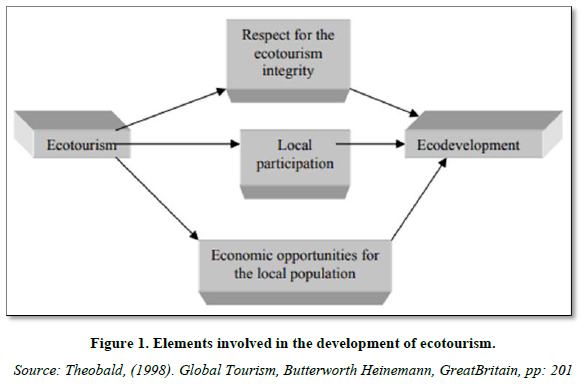
Triple bottom line (people, planet & profit)
The concept of Triple Bottom Line has been quite popular across the world for its emphasis on three Ps (people, Planet & Profit). The impacts of tourism development are assessed economically, socially and environmentally sustainable. The global tourism initiatives to introduce the Global Code of Ethics for Tourism and Tour Operators Initiative by the UNWTO reinforces the efforts towards the responsible tourism. The Tour Operators Initiative is supported by the United Nations Environment Programme (UNEP), the United Nations Educational, Scientific and Cultural Organisation (UNESCO) and the UNWTO.
Responsible environmental practice has other benefits by reducing energy and water bills, sewage treatment and waste disposal costs. Good environmental management also improves the quality of a tourism operation’s surroundings, enhancing the overall experience for guests.
RESPONSIBLE TOURISM AND SUSTAINABILITY
Approach of sustainability has delighted a long history for responsible tourism as a preventive way to deal with sustainability. Sustainable tourism, ecotourism, rural tourism and other socio-cultural related tourism are commonly sharing much with the term Responsible Tourism (Caruana et al., 2014). The elements of general, responsible and sustainable tourism are different. But responsible tourism is the most frequently used term, and which is regularly passed down among the tour operant. The vision behind responsible tourism is creating a more caring tourism industry by, creating a marketplace for responsible holidays and it also requires that operators, government, regional citizens and visitors to take responsibility as a tool to make traversing more sustainable. Improving areas for individuals to live and improving spots for individuals to visit, this is the main intention behind the responsible tourism.
Presently the significance of responsible tourism is to create sustainability. The sustainability concept has served for some as a magic wand pointing towards more sustainable, environmentally and socially friendlier tourism developmental models and forms (Ritchie & Crouch, 2000; Swarbrooke, 1999). On the other hand, the concept has been persistently criticized for being flawed and inadequate (Higgins – Desbiolles, 2010. From the triple pillar concept (Figure 2) we can say that the main perception behind responsible – sustainable tourism is to empower the economic background, development of the community and maintaining an ecological balance and also conserve the gift of god, consider the nature, neighborhood people and the journeyer.
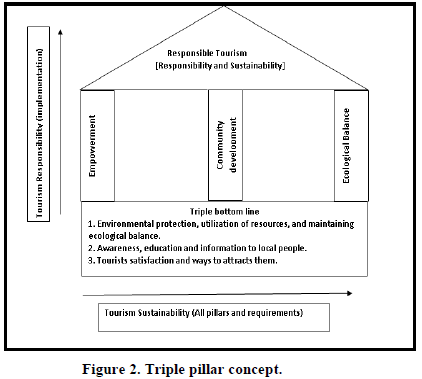
This Triple-A pyramid can be easily followed by the tourism stakeholders to make the destinations more responsible and sustainable.
STUDY AREA
The region selected is Kumarakom Panchayat in Kerala, where the Kerala Government started Responsible Tourism initiative for the first time in the year 2008. Kumarakom Panchayat is located in the Pallom Development Block. Vembanad Lake bound it on the west, Aimanam Panchayat on the north, Thiruvarppu and Nattakam Panchayats on the east and Kainakari and Neelamperoor Panchayats on the south. It has an area of 51.67 square kilometres and it consists of 16 wards (Figure 3).
AIM
To study Responsible Tourism as best practices for sustainable Ecotourism-A Case of Kumarakom in Kerala.
OBJECTIVES
- To explain the concept of Responsible Tourism.
- To study the nature of responsible tourism development in Kerala
- To analyze various responsible tourism initiatives in Kumarakom.
- To measure the level of satisfaction among respondents on various responsible tourism initiatives in Kumarakom.
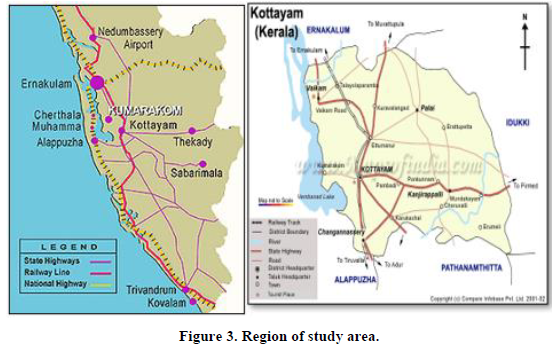
RESEARCH METHODOLOGY
This research paper is basically a concept-based paper. The study of this paper is mainly gathered with some exploratory methods in processing the research. Here sustainability of Responsible Tourism is the main aim.
Here the research was conducted on the basis of an online survey using self-administered questions and also from the available data from different sources. The survey rendered 40 responses. The survey contained 30 questions of personal profile and satisfaction level of responsible tourism projects in Kerala. This approach of study not just spotlights on interchange of knowledge and circulation to add to the current group of tourism theories, above all analytical assumptions, critical thinking and the co-formation of recent information’s are upgraded by gaining from practical as well as academic perspectives. The Secondary data were collected from the Annual reports of Ministry of Tourism Departments at Central and State level, Responsible Tourism wing and Local Government bodies. Various study reports made by different national and international agencies related to Tourism and Responsible tourism topics and also academic papers and scholarly journals.
SIGNIFICANCE OF STUDY
Kerala is known for its scenic beauty and is a popular tourist destination. It was listed as the top 10 ‘paradises found’ in the millennium edition of the National Geographic magazine (Sebastian and Rajagopalan, 2009). Though almost 50% of the state's population was dependent on agriculture until the 1980s, this sector has since declined with farming becoming increasingly unprofitable (George, 1997; Kerala State Planning Board, 2011). Industrial activities in the state are also limited, due to a multiplicity of factors, not least of which was the presence of a militant trade union movement (Tharamangalam, 1997). In terms of natural and cultural assets, Kerala however has a varied portfolio of attractions such as beaches, backwaters, hill stations, festivals, Ayurveda (the traditional Indian medical practice), wildlife, traditional cuisines, classical and folk art and dance forms, unique artefacts and a distinctive style of architecture (Kelly & Kokkranikal, 2010). Tourism was therefore identified as a major economic development alternative. This recognition triggered a series of tourism development and promotional activities in the late 1980s (Kerala State Planning Board, 2011). Tourism was given an industry status in 1986, thus making the sector eligible for all public sector incentives and concessions that were extended to other industries.
Some of the public sector interventions taken during this time include the establishment of a new tourism training institute, Kerala Institute of Tourism and Travel Studies (KITTS) in 1988; formation of District Tourism Promotion Councils in all fourteen districts, to decentralize tourism efforts and make it more spatially sensitive; a year-long campaigning for tourism awareness in 1992 to increase public awareness of tourism related issues. The late nineties and early twenties saw Kerala significantly benefitting from private sector investment in tourism. Public-private joint ventures with leading hotel chains in the country were launched by the setting up of Tourist Resorts Kerala Limited (TRKL) for the purpose.
A concerted effort to implement responsible tourism began with a state level consultation on the subject organized by the Department of Tourism, Government of Kerala, in association with the International Centre for Responsible Tourism and Equations organized at Thiruvananthapuram, the state capital, on the 2nd and 3rd of February 2007.
Responsible Tourism (RT) activities focus mainly on three areas–the economic, social and environmental aspects of the destination. The RT authorities of Kumarakom have planned and implemented various projects with these focus areas in mind. It was in March 2008, that the Responsible Tourism project was officially inaugurated in Kumarakom. The project has been a big success. The local bodies and the self-help groups are very receptive to its plans and initiatives. The project has also been successful in assuring the villagers that tourism can give them a livelihood. It also provides opportunities for interaction with tourists giving the natives exposure to new ideas and cultures, and also gives them a platform for showcasing their talents.
Ecotourism is not a philosophy rather a responsible form of tourism to ensure sustainable tourism development. However, ecotourism, responsible tourism and sustainable tourism must be used interchangeably as each one has its own specific principles for addressing the negative effects of social, cultural, economic, ecological and environmental impacts.
SOME OF THE TOURIST ATTRACTIONS IN KUMARAKKOM
Kumarakom bird sanctuary
The bird sanctuary, also known as the Vembanad Bird Sanctuary, was later developed into an area of 14 acres. It is the first scientifically formed and preserved bird sanctuary in India, with about 180 species of birds. The profuse bird life owes much to the location and the climatic peculiarities of the region. The proximity to Kerala’s largest lake, the fertile, untouched land ideal for insects and the mangroves all contribute to the abundant avian life.
Flora, fauna and flavours of Kumarakom
Apart from the avian fauna, the paddy fields, coconut groves and mangroves, Kumarakom is home to many other varieties of flora and fauna. A large variety of mangrove species can be found at Kumarakom. The mangrove forests provide a suitable habitat for various species of aquatic flora and fauna, including the otter (Lutra lutra). Apart from the mangroves, there are a variety of plants that grow in marshy areas and are very similar to the mangrove.
Lake Vembanad is the habitat for some fascinating marine life. The many species of freshwater fish here include the Karimeen (Pearl Spot), shrimp and prawns. The delicious dishes prepared with these fishes are favorites in Keralite households. Cheppad is a picturesque village in Alappuzha, Kerala. This village has a vibrant agrarian life with most of the people employed in farming.
Boat Races in Kumarakom
The main sport in this land crisscrossed by backwaters is the boat race. The two main boat races of Kumarakom are the Sree Narayana Jayanthi Boat Race (popularly known as Kumarakom Boat Race) and the Kavanattinkara Boat Race.
House boat
The Kerala houseboat is a modified kettuvallam, the large boat of yesteryears. In Malayalam, ‘kettu’ means to tie and ‘vallom’ means boat. These boats were held together with rope and hence the name. Kettuvallams were used for the transportation of goods like rice and spices from Kumarakom and areas of Kuttanad to neighbouring towns. With the emergence and development of modern road and rail transportation, these graceful behemoths were shelved. Their reemergence occurred with the growth of tourism. It is now a tourist attraction and a popular mode to explore the magnificence of the Kumarakom backwaters.
Antique shops at Kumarakom
In and around Kumarakom, there are a few antique shops selling curios that were, until recently, part of the Malayali’s day-to-day life. The items on display include swords and knives, bronze lamps, various household utensils, handicrafts with ethnic designs, elaborately decorated traditional door latches, gramophones, old telephones, coins and so on.
LITERATURE REVIEW
The concept of responsible tourism has been present in the tourism literature since the early eighties (Smith, 1990; Cooper & Ozdil, 1992). Seminal works by DeKadt (1980) and Krippendorf (1987), for instance, raised concerns over the impacts of tourism on the environment and destination communities. In response to increasing instances of social and environmental problems of tourism, a range of sustainability initiatives such as alternative tourism, ecotourism, ethical tourism, green tourism, soft tourism, pro-poor tourism, geo tourism, integrated tourism, community-based tourism, etc. emerged in the tourism literature. Responsible tourism is closely linked to these concepts. These sustainability-oriented alternatives to mass tourism seek to promote environmental conservation, cultural integrity, socioeconomic development and the welfare of communities, especially the disadvantaged sections, living in tourism destinations (TIES, 1990; Scheyvens & Momsen, 2008; Oliver & Jenkins, 2003; Blackstock, 2005; Cawley & Gilmour, 2008; Kontogeorgopoulos, 2009; Weeden, 2002; Hall, 2008).
The sustainability orientation of responsible tourism is stressed by Smith (1990:480), who defined responsible tourism as “a form of tourism which respect the host’s natural, built and cultural environments and the interest of all parties concerned”. Besides the absence of a distinction between responsible tourism and sustainable tourism that this view prompts, the controversies surrounding ‘sustainable tourism’ also gets imported into the debates of responsible tourism. For instance, the sustainability debate is often criticized for its lack of conceptual clarity (Higgins-Desbiolles, 2010); has been characterized as a flawed and inadequate concept that is based on misconceptions on the role of tourism demand, the nature of tourism resources, the imperative of inter and intra-generational equity, socio-cultural integrity, measurement and forms of sustainable development (Liu, 2003); and for offering micro solutions to what is essentially a macro problem of unsustainable growth in tourism (Wheeler, 1991). Wheeler (1991) is critical about the growing number of seemingly environment-friendly tourism initiatives and argues that responsible tourism cannot be a solution for the problems of tourism, as long as the volume of global tourism is on the increase. Any increase in tourism volume will necessarily have a corresponding increase in negative impacts. Therefore, responsible development of tourism will require reducing the scale and volume of tourism. views responsible tourism as “a pleasant, agreeable, but dangerously superficial, ephemeral and inadequate escape route for the educated middle classes unable, or unwilling, to appreciate or accept their/our own destructive contribution to the international tourism maelstrom”.
Many authors argue that reform of and more carefully planned and managed mass tourism could be a realistic way of dealing with the problems of mass tourism (Cohen, 1987; Butler, 1990; Wheeler, 1994). The new interest in environment and sustainability in general could also threaten vulnerable and fragile locations as they become new products of sustainable tourism (e.g., eco-tourism) thus making them vulnerable to the perils of tourism development, and businesses (MacLellan, 1997; Wight, 1993).
Responsible tourism has similarities with pro-poor tourism (PPT) too. This is another form of value-oriented tourism that emerged in the late 1990s. It has the aim of linking tourism and poverty alleviation by focusing on the interests of the poor in tourism destinations (Ashley, Roe & Goodwin, 2001). Goodwin (2001) from the International Centre for Responsible Tourism exemplifies this fuzziness when he argues that ‘responsible tourism is about everyone involved taking responsibility for making tourism more sustainable’.
Social and environmental impacts, responses and indicators are reviewed for the mainstream tourism worldwide in five categories: population, peace, prosperity, pollution and protection (Buckley, 2012). Responsible tourism is an approach to the management of tourism aimed at maximizing economic, social and environmental benefits and minimizing costs to destinations (Responsible tourism policy for the city of Cape Town, 2009).
The central role of tourism businesses in responsible tourism policies is demonstrated by the various Declarations in responsible tourism such as the Cape Town Declaration (2002), the Kerala Declaration (2008), the Alberta Declaration (2011), etc. Martínez, Pérez, and Rodríguez Del Bosque (2013) suggested that RTP may come from social responsibility and an ethical dimension focusing on the local perspectives. Carasuk (2011) and Darson, Wahab, Kassim & Hanafiah (2013) studies suggests that the community’s propositions on responsible tourism were based on environmental practice and tourism development planning. However, there are limited studies about responsible tourism and quality of life dimensions (Figure 4).
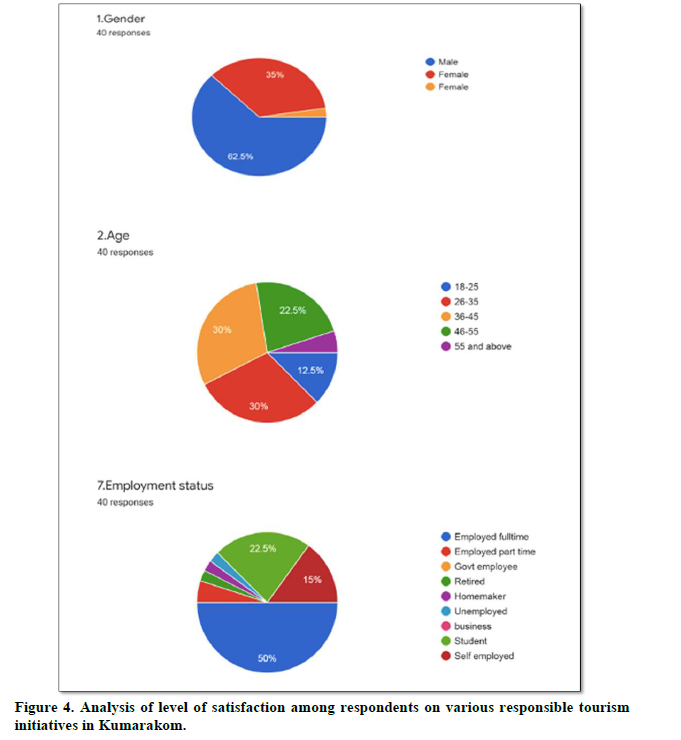
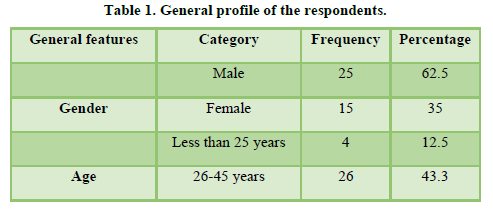
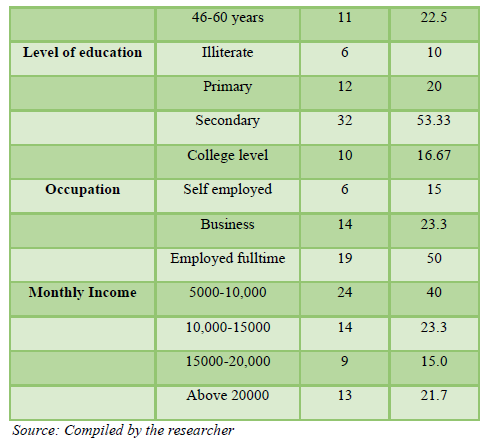



The general profile of the respondents is presented in Table 1 and it reveals that 62.5 percent of the respondents are males and 35 respondents are females. Most of the respondents are belonging to the age group of 26 to 45 years. 53.3 percent of the members have secondary level education and 50 percent of the respondents are employed fulltime and majority of them earns Rs. 5000 to Rs. 10,000 as monthly income.
In order to analyze various responsible tourism initiatives in Kumarakom, these initiatives are grouped under twelve different heads. They are (i) fallow land cultivation and enhanced production, (ii) fish farm and lotus cultivation, (iii) establishing linkages with hotel industry and demand for local resources, (iv) development of souvenir industry, (v) community-based tourism products, (vi) promotion of art forms and culture, (vii) promotion of cultural tourism and ethnic cuisine, (viii) social awareness and tourism management, (ix) protection of environment, (x) energy saving measures, (xi) comprehensive resource mapping and (xii) destination labor directory. Each of these heads comprises around one to seven sub variables totaling thirty-eight sub- variables.
The satisfaction Level of the business houses with the Present Responsible Tourism Policy of the Government, Table 2 revealed that the majority of the Business Houses (30%) have a very high or high level of satisfaction with the current Government policy and 20% have a low or very low level of satisfaction with this aspect.
The level of Satisfaction with Present Responsible Tourism Projects undergoing at Kumarakom revealed that 36% business houses have a very high or high level of satisfaction and 20% of them have a low level of satisfaction level in this aspect. The study revealed that the majority of the business houses were satisfied with the Present Responsible Tourism Projects undergoing at Kumarakom Panchayat and was seen as an economic tool of prosperity (Table 3).
The interpretation is that the level of satisfaction of the respondents about various responsible tourism initiatives in Kumarakom is not moderate (or average). Based on the mean score (all mean scores are above three) it can be concluded that they are satisfied with the responsible tourism initiatives or their level of satisfaction is above average (Table 4).

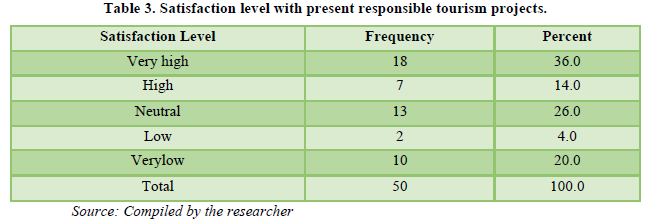
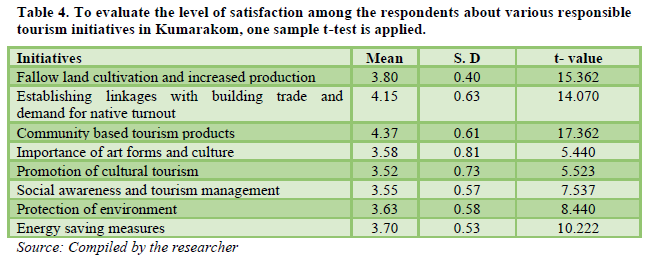



CONCLUSION
Ecotourism is a key form of promoting responsible travel in the natural scenic places gifted with wildlife, forests and indigenous people. Responsible tourism educates the judicious use of resources and emphasizes on green energy, recycling, solid waste management, use of local products, sale of local crafts, eradication of poverty and unemployment. Thus, responsible tourism is an approach for establishing sustainable relationship between local communities for dynamic economic linkages. Responsible Tourism in Kerala proves the capability of Local Self Government to build industry-community trust and the leadership to coordinate activities in triple bottom line areas. The study also reveals that the development of infrastructure, more employment opportunities, stimulation of business activity, concern for culture and history, conservation of historical monuments and ecology, women empowerment etc. are the benefits derived from the new and innovative tourism practice.
SUGGESTIONS
There are only limited studies tourism with developing countries so there is a wider scope for further studies. Studies can be made on the government policies, measures, planning and development of tourist spots in relation to the need of the growing tourism demands.
As a major area of research, women empowerment can be analyzed from the perspective of tourism development. Study can also be made on tourism and its growing environmental effect and the measures to protect environmental damages caused by tourist inflows.
- Ashley, C., Roe, D. & Goodwin, H. (2001). Pro-Poor Tourism Strategies: Making tourism work for the poor. Available online at: https://www.odi.org/sites/odi.org.uk/files/odi-assets/publications-opinion-files/3246.pdf
- Aswathy, M.J. (2016). Growth of tourism industry in Kerala and need for sustainable tourism development. International Research Journal of Multidisciplinary Studies 2(3), 1-12.
- Bramwell, B., Lane, B., McCabe, S., Mosedale, J. & Scarles, C. (2008). Research perspectives on responsible tourism. Journal of Sustainable Tourism 16(3), 253-257.
- Buckley, R. (2012). Sustainable tourism: Research and reality. Annals of Tourism Research 39(2): 528-546.
- Blackstock, K. (2005). A critical look at community-based tourism. Community Development Journal 40(1).
- Butler, J. (1990). Gender Trouble: Feminism and the Subversion of Identity. Abingdon: Routledge.
- Cooper. C., Fletcher. J., David., Gilbert. & Wanhill. S. (1993). Tourism - Principles and Practice, pp: 290.
- Crouch, G.I. & Ritchie, J.R.B. (1999). Tourism, competitiveness and societal prosperity. Journal of Business Research 44(3), 137-152.
- Carasuk, R. (2011). Responsible Tourism Qualmark Accreditation: A Comparative Evaluation of Tourism Businesses and Tourists’Perceptions. Lincoln University. LEaP.
- Cohen, E. & Yehuda, N.B. (1987). Counter‐Cultural Movements and Totalitarian Democracy. Sociological Inquiry 57(4), 372-393.
- Cooper, C.P., & Ozdil, I. (1992). From mass to ‘responsible’ tourism: the Turkish experience. Tourism Management 13(4), 377-386.
- Desbiolles, F.H. (2010). The Elusiveness of Sustainability in Tourism: The Culture-Ideology of Consumerism and its Implications. Tourism and Hospitality Research 10(2).
- Darson, M., Wahab, M., Kassim, E., & Hanafiah, M. (2013). Responsible tourism: Linking perceived benefits and practices in Pangkor Island. Hospitality and Tourism: Synergizing Creativity and Innovation in Research, 29.
- Department of Tourism, Govt. of Kerala. (2016). Kerala tourism trends, trade survey. Available online at: https://www.manoramaonline.com/content/dam/mm/ml/news/latest-news/pdf/2016/jan/Kerala-Tourism-Trends-Trade-Survey-Report.pdf
- Experience Kerala. Available online at: www.Kerala tourism.org
- Fennel, D. (2002). Ecotourism policy and planning. CABI publishing, pp: 368.
- Hall, J., & Matthews, E. (2008). The Measurement of Progress and the Role of Education. European Journal of Education 44(1), 11-22.
- Kerala Travel and Tourism Studies (2008). Local impacts of tourism development in Kerala: A study on selected centers.
- Kelly, C. & Kokkranikal, J. (2010) “The evolution and commodification of Wellness Tourism in India: A case study of Kerala”; a conference paper for the Tourism and Travel Research Association Conference, Budapest, Hungary, 21-23.
- Kontogeorgopoulos, N. (2009). Wildlife tourism in semi-captive settings: a case study of elephant camps in Northern Thailand. Current Issues in Tourism 12(5-6), 429-449.
- Kumarakom (2020) Available online at: https://en.wikipedia.org/wiki/Kumarakom
- Lee, T.H. (2013). Influence analysis of community resident support for sustainable tourism development. Tourism Management 34, 37-46.
- Liu, Z., Sekito, T., Spírek, M., Thornton, J. & Butow, R.A. (2003). Retrograde signaling is regulated by the dynamic interaction between Rtg2p and Mks1p. Molecular Cell 2(2), 401-11.
- Maclellan, E. (1997). The role of concrete materials in constructing mathematical meaning. International Journal of Primary, Elementary and Early Years Education 25(3): 31-35.
- Mathew, P.V. & Rupesh, K. (2014). Responsible Tourism - A grass root level empowerment mechanism: Case study from Kerala. Innovative Issues and Approaches in Social Sciences 7(1), 53-70.
- Santhimol M.C. (2015). Responsible tourism in Kumarakom-An analysis. International Research Journal of Management and Commerce 2(6), 1-10.
- Shiji, O. (2020) Tourist penetration rate and index of tourism intensity in Kerala. Available online at: http://www.universalreview.in/assets/uploads/doc/69b73-10-21.15302.pdf
- Spenceley, A. (2010). Responsible tourism: Critical issues for conservation and development. Routledge, pp: 416.
- Sebastian, L.M. & Rajagopalan, P. (2009). Socio-cultural transformations through tourism: A comparison of residents’ perspectives at two destinations in Kerala, India. Journal of Tourism and Cultural Change 7(1), 5-21.
- Smith, A.D. (1990). Towards a Global Culture? Theory, Culture & Society 7(2-3), 171-191.
- Scheyvens, R. & Momsen, J. (2008). Tourism and Poverty Reduction: Issues for Small Island States. Tourism Geographies 10(1), 22-41.
- Sudheer, B. (2015). Economic and Cultural impact of Responsible Tourism initiative in Kerala-A case study of Kumarakom Panchayat. Available online at: http://www.sncollegecherthala.in/research%5Csudheer.pdf
- Tourist map of Kumarakom City (2020) Available online at: http://www.touristplacesinindia.com/kumarakom/kumarakom-maps.html
- Weeden, K. (2002). Why Do Some Occupations Pay More Than Others? Social Closure and Earnings Inequality in the United States. American Journal of Sociology 108(1), 55-101.
- Wheeler, L. & Reis, H.T. (1991). Self‐Recording of Everyday Life Events: Origins, types, and uses. Journal of Personality 59(3), 339:354.
- Wheeler, M. (1994). Ethics and the Sports Business. Business Ethics. The Environment & Responsibility 3(1), 8-15.
- Wight, P. (1993). Ecotourism: Ethics or Eco-Sell? Journal of Travel Research 31(3), 3-9.





